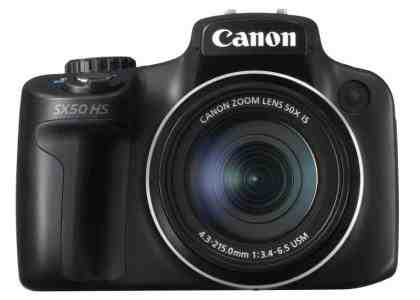Ultra-zoom cameras are incredibly versatile, taking wide-angle, telephoto and macro photography in their stride. The best models cope well in low light too. Last year's Canon SX40 HS led the field for image quality, particularly in low light, but narrowly missed out on an award because of its trundling performance.

This year's SX50 HS ups the ante with a record-breaking 50x zoom lens – the biggest ever to grace a stills camera. More importantly to us, it's also significantly faster in general use, taking 1.8 seconds between shots. That's a big improvement on the SX40 HS's 2.8 seconds but still a long way off 0.6 seconds of the Panasonic Lumix DMC-FZ200 .

Continuous mode is seriously fast, capturing 10 shots at up to 14fps in our tests. However, this performance is only available in a scene preset with barely any control over the camera, and it took six seconds to save these shots before we regained control of the camera. Most situations require more sustained performance, but the best it could manage outside of this scene preset was 1.9fps, or just 0.9fps with continuous autofocus. The screen was blank for most of the time between each shot, which made it virtually impossible to track moving subjects.
It's much more capable when shooting sedentary subjects. The 1200mm maximum focal length (35mm equivalent) let us frame subjects that we could barely see with the naked eye. Using such a huge magnification while shooting handheld meant we often lost track of the subject, so we really appreciated the button on the side of the lens to zoom out quickly and temporarily to help locate it again.

The rest of the controls and well laid out, with a dedicated button for moving the autofocus point and a custom button that can be assigned to one-click white balance calibration. There's no button to toggle between the screen and electronic viewfinder, though. Instead, this is achieved by pressing the Display button twice, which felt too longwinded. Then again, the electronic viewfinder's small size and low 202,000-dot resolution meant we didn't have much of an urge to use it. The LCD screen is a little smaller than usual, too, at 2.8 inches, but its resolution is sharper than the SX40 HS's.
Video capture is at 1080p at 24fps. Quality in our tests was excellent, and we're amazed at how effective the optical stabilisation was at keeping handheld shots steady, even at the full zoom extension. Details weren't quite as sharp as from the FZ200, though, and low-light clips were noisier. It also lacks the FZ200's mic input and comprehensive manual control over video exposures. Clips are limited to around 16 minutes and slow-motion clips are at VGA resolution. The FZ200 is undoubtedly the better video camera.






Leave a Reply